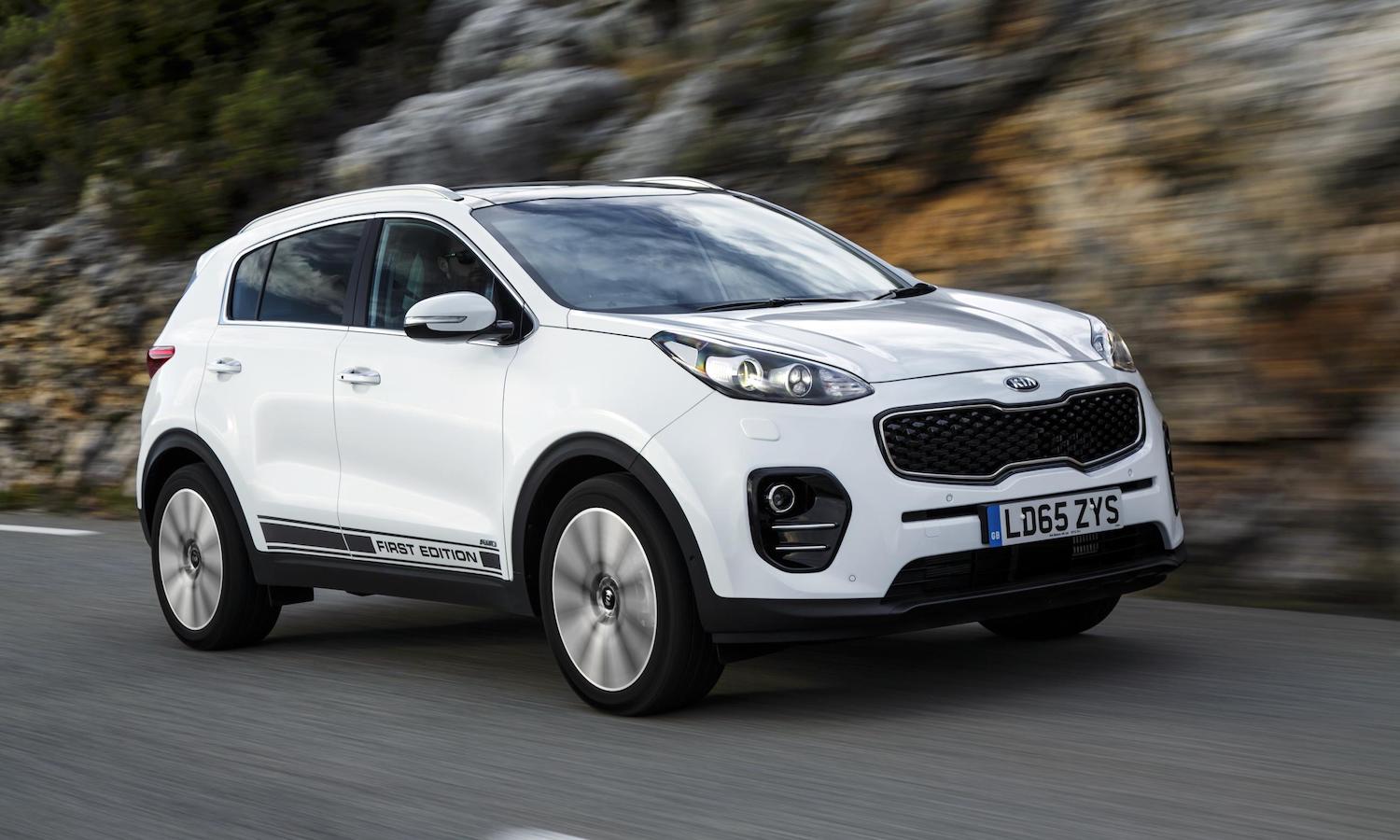What is it?
Fourth generation of brand-redefining SUV.
Key features:
More efficiency, more new technology, sporty GT-line trim level.
Our view:
There’s every reason to believe the Kia Sportage will continue to be the biggest seller in the company’s UK operations.
The importance of the Sportage SUV to Kia, particularly in the UK, cannot be overestimated. This is the car that when it first launched in 1995 began the transformation of the Korean brand into the volume player it is today.
Described by its makers as one of the first of the ‘compact crossovers’ that everyone now wants, the Sportage has evolved through three generations and become Kia UK’s best seller. It’s a measure of the model’s importance that in 2015, its run-out year, the Mk3 recorded its best UK performance, 23,010 sales boosting its slice of the brand’s total volume from the usual 20 per cent to 29 per cent.
Now the fourth generation Kia Sportage has arrived – an all-new model with promised improvements in all areas, and an expectation that it will routinely take 28 per cent of sales as the brand works towards its stated target of a 100,000 annual volume by 2020.
The recipe is familiar in today’s market – improved efficiency from new and revised powertrains; an upturn in quality in line with a push upmarket; and lots of new technology both in terms of safety features and desirables such as extra connectivity.
One of the most obvious changes on first sight of the car is its styling. The previous Sportage was quite conservative in its visuals, whereas this version has gone much more radical.
It’s particularly noticeable at the front end, where the signature ‘Tiger Nose’ grille is now much wider and separated from the headlamps, these moved up onto the top corners of the bonnet, sweeping around and along it. And the fog-lamp clusters are now on their own, in vertically shaped pods.
The new Sportage is 40mm longer than the Mk3, with a 30mm longer wheelbase which of course translates to interior space improvements. But the car’s width and height remain unchanged, and with a shorter rear overhang the resultant profile is certainly distinctive – more purposeful with a side view that has a lot more metal than glass. In this reviewer’s view it looks better in profile than three-quarter, and it will certainly divide opinions much more than the outgoing model.
Slip behind the wheel and the immediate impression is of much time being spent to offer an environment of higher quality. There are plenty of premium-feel soft-touch surfaces where they will be most obvious, though they don’t extend too low down.
The redesigned dash layout is split into what Kia describes as the upper Display Area, dominated from 2 grade models upwards by a touchscreen unit in either seven or eight-inch size, and the lower Control Area.
A nice touch is the gentle angling of the centre console towards the driver, by seven degrees, which adds to the cockpit-like feel. And this is further emphasised by Kia’s apparent rejection of the current trend towards minimising controls. There are no less than four rows of switches, all neatly grouped, and with a fifth row of Aux and USB sockets and such like below. It looks impressive, but also somewhat too numerous.
Having said that, the cockpit is easy to get comfortable in while there is plenty of room for passengers front or back, and more boot space. This is up by 26 litres to 491 litres with all seats in place – better than the rival everyone in this sector has to beat, Nissan’s Qashqai. And the rear seats now fold much flatter than previously which extends space to 1,480 litres.
Of the five engine options, just one is completely new – the 1.6-litre T-DGi petrol unit of 174bhp, which is available only with the new and sports-pitched GT-Line trim level.
Kia adds, however that the four carry-over units – a 1.6-litre 130bhp petrol, a 1.7 114bhp diesel and 2-litre diesels with either 134 or 182bhp – have all been extensively revised to meet Euro 6 emissions regulations. As a result all offer significant fuel economy and CO2 emissions improvements – the most popular 1.7 unit, which takes half of all sales, has increased its combined cycle economy by 7mpg while losing 16g/km in CO2 emissions, and in the 2-litre diesels the emissions cuts are of more than 20g/km.
On the launch event, The Car Expert tried the new petrol engine and the 1.7 and 2.0-litre 182bhp diesels. Petrol propulsion is staging a bit of a comeback at present and for such preferences this engine will appeal – it is very smooth and refined, and flatters to deceive. While not giving an impression of urgency or pace, it turns in a very respectable 9.2-second 0-60mph time, shaving this to 8.8 seconds when paired with a seven-speed 7DCT auto transmission.
The high-powered diesel matches the petrol unit in both pace and refinement, and has benefited from its torque both being increased and widened in range, but interestingly the 1.7 diesel, the most popular engine, feels the most dated in the line-up, initially slightly agricultural compared to its siblings. However it soon warms up and smoothes out as a result.
No faulting the transmissions, either six-speed manual or seven-speed auto, or the chassis. Increased use of high-strength steel and hot metal stamping contributes to a shell some 39 per cent more torsionally stiff than its predecessor, and it shows in the handling.
The south of France launch test route included a mix of challenging mountain roads peppered with hairpin bends of varying speeds, and the Kia took them all in its stride, cornering with confidence while remaining upright and with plentiful grip. A compliant ride completes impressive road manners.
The Kia Sportage is being sold in front and all-wheel-drive form and the usual 1, 2, 3 and 4 grades, plus the new GT-Line which is only available with the new petrol unit and the 134bhp 2-litre diesel, in front-wheel-drive. Sitting between levels 2 and 3, it adds extra equipment plus exterior and interior styling packs.
There is also a launch special model dubbed the First Edition. It is presented as a range-topper, the extra niceties including metallic white or black paint, a parking assist system and wireless phone charger. It also demonstrates Kia’s confidence in the Sportage, having a £31,645 price tag.
The range as a whole starts rather less expensive, £17,995 buying the 1.6 petrol version in front-wheel-drive form. And with a five-star Euro NCAP safety rating, seven-year warranty and low insurance groups, starting from group 11, there’s every reason to believe the Kia Sportage will continue to be the biggest seller in the company’s UK operations.
Kia Sportage – key specifications
Models tested: Kia Sportage 1.7 CRDi manual, 2.0CRDi 182bhp auto, 1.6 T-DGi manual AWD.
On Sale: February 2016.
Range price:£17,995-£31,645.
Insurance groups:From Group 11.
Engines: Petrol 1.6 (2). Diesel 1.7, 2.0 (2) .
Power (bhp):130/174. 114, 134/182.
Torque (lb/ft):119/195. 207, 275/295.
0-60mph (sec):11.1/9.2 (auto 8.8). 11.1, 10.1 (11.6)/9.2.
Top speed (mph): 113/126 (125). 109, 114/125.
Fuel economy (combined, mpg): 42.2(ISG 44.8)/37.2 (auto 37.7). 61.4, 54.3 (47.9)/47.9 (44.8).
CO2 emissions (g/km):156 (ISG 147)/177 (auto 175). 119, 139 (154)/154 (166).
Keyrivals: Nissan Qashqai, Volkswagen Tiguan.
Test Date: February 2016.










